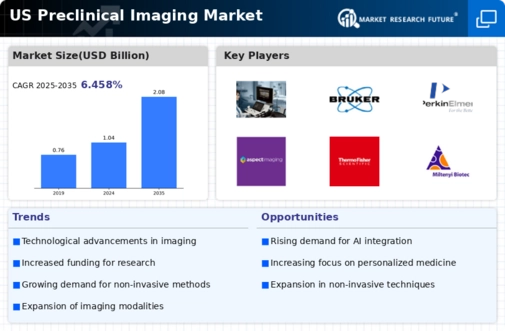The US Preclinical Imaging Market is an ever-evolving landscape characterized by advanced technologies and innovations aimed at enhancing biomedical research. The competitive dynamics within this market are fueled by an increasing demand for effective preclinical imaging solutions that provide critical insights into the biological processes of diseases. The market is driven by factors such as rising investments in life sciences research, the pursuit of novel therapeutic approaches, and regulatory support that encourages the development of cutting-edge imaging modalities.
Various players within the market are strategically positioning themselves by offering a diverse range of imaging technologies, such as magnetic resonance imaging, optical imaging, and nuclear imaging systems. This competitive ecosystem fosters innovation while providing researchers with essential tools to push the boundaries of preclinical study.
Mediso
Mediso has established a notable presence in the US Preclinical Imaging Market, recognized for its high-quality imaging systems designed for various applications in life sciences. The company focuses on providing advanced imaging solutions that enhance research capabilities in pharmacology, oncology, and neurology. Known for its commitment to technological advancement, Mediso offers products characterized by a significant level of precision and speed. Furthermore, its strong customer support and tailored service offerings add to its competitive edge in the US market, making it a preferred choice among research institutions and pharmaceutical companies.
The company’s relentless innovation is coupled with partnerships with leading research organizations, which further solidifies its reputation and positioning in a competitive landscape.
Bruker
Bruker, another key player in the US Preclinical Imaging Market, offers a comprehensive portfolio of preclinical imaging technologies that cater to a wide array of research needs. The company is recognized for its sophisticated imaging modalities, including magnetic resonance imaging, fluorescence imaging, and multi-modal imaging systems. Bruker's strengths lie in its deep integration of imaging technologies with powerful analytical capabilities, enabling researchers to extract meaningful data from their studies efficiently. The presence of Bruker in the US market is robust, reinforced by strategic mergers and acquisitions that have expanded its product offerings and market reach.
In addition to high-quality imaging systems, Bruker emphasizes collaborations with academic and research institutions, which further enhances its credibility and market presence. This multifaceted approach ensures that Bruker maintains a competitive advantage, by providing innovative solutions that meet the evolving demands of preclinical research in the US.





















